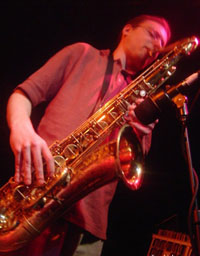
Jeff Sackmann is a composer, saxophonist, and bandleader with an embarrasing affection for bubblegum pop.
In an effort to create serious music for his 15-piece jazz orchestra, Oy Christina!, he has combined baroque fugue with Justin Timberlake, introduced serialism to Eminem, and spiced up dance mixes with Coltrane changes. For his trio Single White Female, among others, he has written several dozen pieces for small jazz ensemble that occasionally bridge the gap between chamber music and traditional combo playing.
As a saxophonist, Jeff spent several months performing with Clyde Stubblefield, the original funky drummer. He plays with a variety of rock bands in New York City and spent three years as the music director for the swing band Little Red and the Howlers.
Hailing originally from Spokane,Washington, he spent his undergraduate years at New York University, did graduate work in English Literature at the University of Wisconsin-Madison,and studied music at Berklee.
|

3.01.2006
Intermission Riff
I don't like intermissions. Yeah, I suppose they are necessary as a bathroom break for everybody, as an outlet for all the things people just barely (or just barely didn't) keep themselves from saying to their friends during the performance, or as a chance to reflect on a segment of the performance. But I think it's gone too far.
I'm sure there are venues where the length of intermission has always been obnoxious, and I suppose it's inevitable in large houses (especially a barn like the Met) where the distance from a front-row seat to the nearest lounge would be considered a middle-length Olympic event. But lately, I've been clocking breaks that exceed 25 minutes. As I used to ask my classes when I sensed a few people clamoring for a break: "Wouldn't you rather charge on and go home that much sooner?" As my classes knew, of course I did.
My other problem, especially at chamber music concerts where the instrumentation varies, is the length of breaks between pieces. Last Thursday, at the Luigi Dallapiccola composer portrait at Miller Theater, it took at least a couple of minutes after each piece to reset the stage and resume the performance. I wish I had been clocking those breaks: I wouldn't be surprised if the pauses in the program, taken together, were longer than either half.
I'd like to be able to point to an offender, or class of offenders, and say, "You there, stop it with the breaks!" But with between-pieces pauses, it's tough to pinpoint the problem. Of course, you wouldn't have the problem if the instrumentation never changed, so perhaps the program planners are at fault. I suppose managers could encourage stagehands to hustle, but I doubt that would do much except for entertain those of us close enough to the stage to see people pushing a grand piano around a little faster.
One solution is suggested by Alarm Will Sound, whose members have always been very good about this. Perhaps it's their attitude that they, the performers, are responsible for every aspect of the show: I've seen AWS members leave the stage with chair and stand in hand, making room for someone else to immediately do whatever else must be done. That sort of thing is unthinkable at your stereotypical uptown concert, but it does the trick.
Back to intermission. A few years ago, when I was mostly going to avant-jazz shows, I hated the inevitable hour-long break between sets. (I suppose, compared to that, 25-minute intermissions shouldn't bug me.) Watching the inevitable flow of people out the door about fifteen minutes before the second set, I always wondered if those people would stick around if the break weren't so long. Move the second set up to 9:30, and maybe keep some more people in the house.
So, when I was performing somewhat regularly, I tried it. Instead of publicizing 8 & 10pm, I made it 8 and 9:30. What's more, I stuck with the usual practice of starting the 8:00 set late, but I stuck to 9:30. This led to a lot of surprised musicians when I made my way around the bar, letting everybody know we were about to go back on, but it meant that rather than an hour-long break, the time from the last song of the first set to the first of the second was more like 20 minutes. I figured, confidently, I'd get more of the early birds to stay for the second set.
Ha! Every week, like clockwork, the people who would've left in the middle of the break snuck out in the middle of the first song of the second set. They were all very nice, waving as they left...but they left.
I'd like to have a grand conclusion here to tie all these threads together, but I don't. The lesson I took away from my experiment is twofold. First, you don't mess with that sort of tradition. You can try, but people aren't going to change their habits for you. (Well, not for me, that's for sure.)
Second, never underestimate the social aspect of concertgoing. I suppose this is obvious, but it's easy to forget when you go to a few concerts a week, sometimes alone, sometimes with a study score. The vast majority of concertgoers will never object to an extra three minutes at intermission--they're chatting with a friend, they're enjoying the ambience of Carnegie Hall, they're seeing and being seen. Heck, they might need the men's room and a smoke. But I'm pretty sure they're not worried about the concert holding together as a unified whole...or getting home by 10:30.
posted by Jeffrey Sackmann
|
| |



